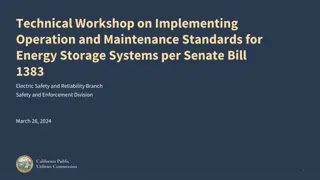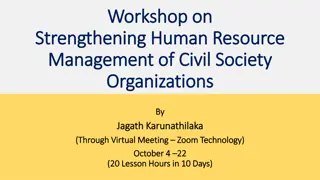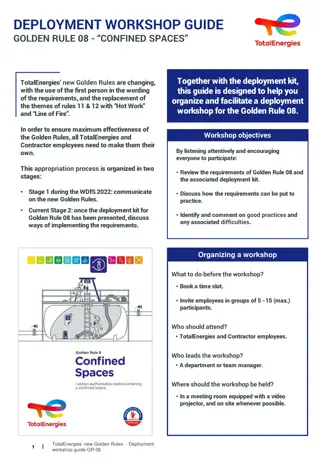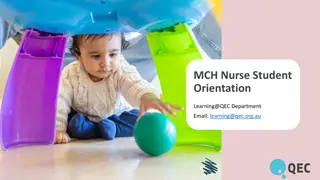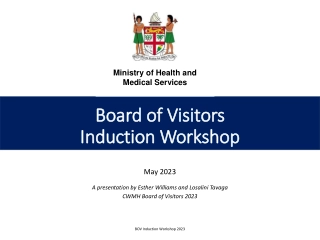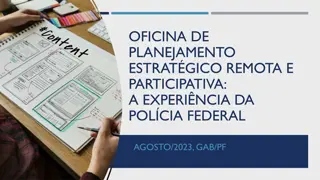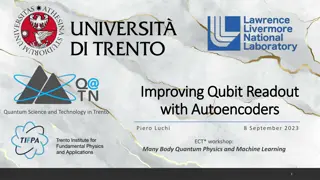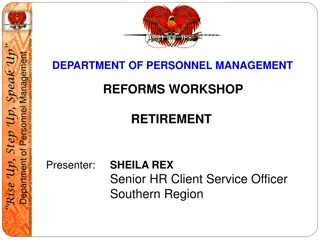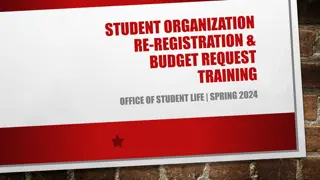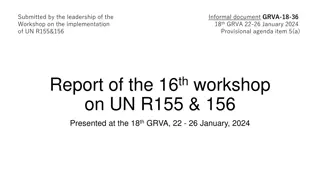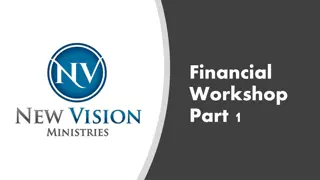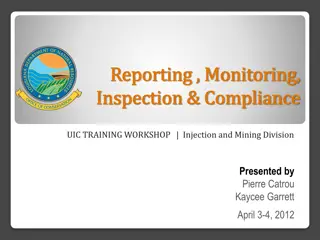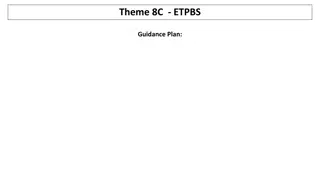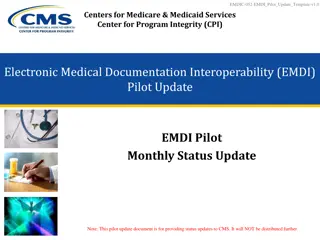Comprehensive Guide to Workshop Organization and Implementation
Workshops play a crucial role in developing psychomotor skills and practical knowledge in education. Defined as a group of individuals meeting to enhance skills through study, research, and practice, workshops involve active participant involvement and focus on practical experiences. Essential features include active participation, role-playing, and a focus on current professional issues. Key principles emphasize participant motivation, active involvement, human relations, and cooperation. Workshop objectives typically encompass cognitive and psychomotor goals aimed at improving teaching practices. Effective workshop organization and implementation rely on a collaborative and engaging approach.
Download Presentation
Please find below an Image/Link to download the presentation.
The content on the website is provided AS IS for your information and personal use only. It may not be sold, licensed, or shared on other websites without obtaining consent from the author. Download presentation by click this link. If you encounter any issues during the download, it is possible that the publisher has removed the file from their server.
- Workshop organization
- Psychomotor skills
- Active participation
- Professional development
- Teaching practices
Uploaded on Apr 02, 2024 | 0 Views
Presentation Transcript
Introduction Disadvantage Definition CONTENT CONTENT Essential Features Of Workshop Advantages Principles Of Workshop Follow Up Objectives Of Workshop Procedure
The workshops are organized to develop the psychomotor aspects (skill development) of the learner regarding practical of new innovations in area of education. Under this technique participants have do some practical work to produce instructional teaching and testing material. INTRODUCTION
DEFINITION DEFINITION Workshop is defined as assembled group of 10 to 25 persons who share a common interest or problem. They meet together to improve their individual and skill of a subject through intensive study, research, practice and discussion Workshop is a meeting during which experienced people in responsible positions come together with experts and consultants to find solutions for the problem that cropped up in the course of their work and they have had difficulty in dealing with on their own. It is large group discussion method.
ESSENTIAL FEATURES OF WORKSHOP COMPLETE ACTIVE INVOLVEMENT BY THE PARTICIPANTS. THE WHOLE POINT OF ATTENTION IS TO WORK AND LEARN FROM PRACTICAL EXPERIENCES. PARTICIPANTS MAY HAVE TO WORK AS REPORTERS OR A LEADER.
PRINCIPLES OF WORKSHOP PRINCIPLES OF WORKSHOP Allowing the participant to prepare and select objectives to be reached will increase the participants motivation. Giving the participants an active role will make teaching more effective. Improve a person's attitude towards other people. Learn better human relations. Cooperation is a technique and a way of life that is superior to competition and is a primary factor to be allowed. Workshop should focus on the current issues in the profession to be discussed. Giving the participants an active role will take teaching more effective. Every individual have worth and contributes to the common goals. Workshop should be conducted with full cooperation within organizers.
OBJECTIVES OF WORKSHOP There are two objectives 1. COGNITIVE OBJECTIVES To solve the problem of the teaching profession To philosophical sociological background instructional teaching situation. provide the and To educational objectives in the present context identify the To understanding regarding the use of theme and problem develop an Psychomotor objective Cognitive objective for and
Psychomotor Objective Psychomotor Objective To develop the skills to perform task independently To determine and use of teaching strategies effectively To train the persons for using different approach of teaching. Workshop technique is used to seed, explore and identify the solution to a problem. It is used for in-service teachers for giving awareness and training of new practice education. It provide an opportunity to prepare specific professional, vocational and community service function
PROCEDURE PROCEDURE The organization of the workshop can be divided into 2 phases:- 1. Pre-active phase 2. Active phase 1. THE PRE-ACTIVE PHASE STEP 1 :- (DEFINE THE GOAL) Every workshop must have a goal, clear goal should be kept at the center of the discussion STEP 2 :- (DECIDE THE TARGET GROUPS) Knowing who will participate directly refers to the objectives. Make a list of people who needs to be there. Try to be as specific as possible, but leave a few openings for last-minute additions STEP 3 :- (SELECT THE RIGHT LOCATION) Think about the logistics and practical details of the workshop for the selection of the location. Make sure that everyone be able to see the visual aids. Also make sure that the appropriate facilities for breakout sessions. Will everyone be able to reach venue or need to organize accommodations for people who are coming from a long way.
STEP 4 :- (PREPARE AN AGENDA) MAIN POINTS Create a list of main points to discuss and breakdown each larger point into details. VISUAL AIDS List the visual aids if any, to be use for each point. If need technical support provide expert help, this helps the people to determine where they need to focus their efforts. DISCUSSION AND ACTIVITIES Take a time to list exactly which group discussion and activities will be used at which point, in the workshop. How much time will be allowed for each exercise? Make sure that activities are appropriate for the size of the group and ensure that the venue has the resources. STEP 5 :- (DEVELOP A FOLLOW-UP PLAN The only way to find out if the workshop was a success is to have an effective follow up plan. Create a questionnaire to give to all participants at the end of the event and give them plenty of opportunity to share their opinion on how well it went. It is the only way to learn and improve for the next time.
2. THE ACTIVE PHASE STAGE 1 :- Presentation of the theme for providing awareness. Resources persons or experts are invited to provide the awareness and understanding of the topic. Paper reading is done to discuss the different aspects of the theme. In the first stage theoretical background is provided to the participants. STAGE 2 :- Practice the method for its applicability. In the second stage the group is divided into small group on basis of language, subject's studies and every participants has to work individually and independently. A resources person or expert is assigned to provide the guidance for the work to be performed. Every trainee has to complete the task within the given period. At the end they meet in their groups and discuss and present their task to be completed. STAGE 3 :- At the round up of workshop, a representative of each group will then be asked to present the findings. In second stage, the participants are required to elaborate a meaningful ordering scheme for the thus for collected context elements. The round up will be a reflective discussion with all workshop participants ; where the experience of teaching methods is put into personal (e.g. :- what value participants see in the use of teaching method ; or what elements regarding the context cause uncertainties with participants.)
FOLLOW UP IT IS AN IMPORTANT PART OF GOOD WORKSHOP. EFFECTIVENESS IS ASCERTAINED BY AN OBJECTIVE FOLLOW UP. THE TRAINEES ARE ASKED TO CONTINUE THEIR TASK AND EXAMINE ITS WORK ABILITY AND INABILITY IN THEIR WORKING SETUP (INSTITUTIONS). THE PARTICIPANTS ARE INVITED TO MEET AGAIN AND PRESENT THEIR INSTITUTIONS FEEDBACK REGARDING APPLICABILITY OF THE TOPIC OR NEW PRACTICES. THEY MAY GIVE SOME PRACTICAL SUGGESTION IN THIS CONTEXT. AND LAST REPORT OF THE WORKSHOP IS PREPARED.
1. Use to realize the higher cognitive & psychomotor objectives. 2. Used for developing understanding & proficiency for the approaches and practices in education. 3. Provide opportunity and situations to develop the individual capacities of a teacher. 4. Develops the feeling cooperation and group work or teamwork. 5. Provides the situations to study the vocational problems. 6. It introduces new practice & innovations in education. 7. It is used for developing and improving professional efficiency , e.g., nursing, medical, dental, etc. 8. The teacher proficiencies can be developed by using the workshop technique for in-service teaching. ADVANTAGES
DISADVANTAGES DISADVANTAGES The workshop in education are seminar cum-workshop on any theme or problem. The in-service teachers do not take interest to understands and use the new practices in their classrooms. The workshop can not be organized for large group so that large number of persons are trained. The teacher do not take interest in practical work or to do something in productive form.
CONCLUSION CONCLUSION Workshop may be a room or building which provides both the area and tools ( machinery ) that may be required for the manufacture of repair manufactured goods. Workshop were the only places of production until the advent of industrialization and factory.


